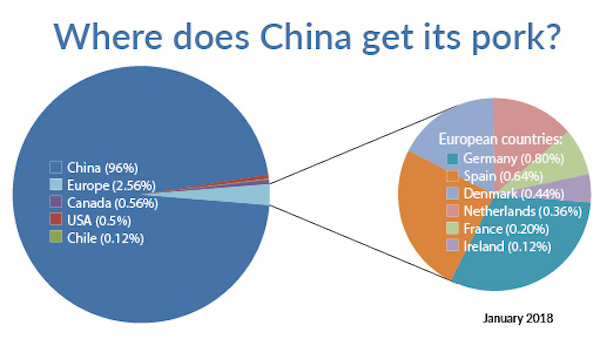China is both the world’s biggest pork producer and consumer. The country is home to roughly half the world’s pigs and consumes nearly half the world’s total pork output. China’s own pork production has more than doubled since 1990, climbing from 22.8 million metric tons (MMT) to more than 55 MMT in 2022. Pork has not always been a main consumer staple, however. Up until the last 40 years, pork was mostly a rare treat but as living standards have improved, so has the Chinese diet. Below are some other interesting facts about China’s pork industry and how its growth over the past few decades has reshaped other ag markets.
Ancient China – Genetic and archaeological evidence shows that people in China domesticated pigs from wild boar about 8,000 to 9,000 years ago. By the Bronze Age (ca. 4,000 years ago) pigs were one of the most common domestic animals in China and played important roles throughout Chinese culture. As people farmed the land more intensively, pigs became more prized for their manure than anything else. Most families only kept a few pigs, so they only ate them on special occasions.
Contribution of Chinese Pigs to Modern Breeds – The result of millions of farmers breeding pigs over millennia was the creation of a wide variety of regional breeds. In 1960, China’s first national survey of indigenous livestock identified more than one hundred indigenous pig breeds, with countless locally adapted varieties that could thrive in a variety of landscapes and climatic conditions. Eventually, these southern pigs were carried to Europe, where they were bred with local pigs to create the industrial hog breeds that now constitute most of the world’s pigs.
Decline in Backyard Farming – Farming didn’t change much in China until around the Communist Revolution of 1949 when Chairman of the Chinese Communist Party Mao Zedong reworked the countries agriculture system. Mao’s poorly planned “Great Leap Forward” contributed to the Great Chinese Famine between 1959 and 1961, widely regarded as the deadliest famine and one of the greatest man-made disasters in human history. Tens of millions of Chinese died. During that same time, the government forced millions of people from the countryside to join the iron and steel production workforces in cities, further contributing to a decline in rural population and backyard farmers.
China’s Urban Boom – After the country’s recovery from the Great Famine and reforms were launched, the urban population began to explode. The urban population grew from about 3% in 1950 to roughly 33% by the end of 1985 and nearly 65% today. As the structure of Chinese society shifted, so too did eating habits. In the mid-1970s, Chinese pork consumption averaged around 17 pounds per year. That has grown to nearly 55 pounds today. China’s population has also boomed over that time, climbing from roughly 818 million in 1970 to 1.4 billion today.
Rise of Factory Farms – Soon after the Cultural Revolution ended in 1976, the government initiated its program of “Reform and Opening,” launching selective liberalization and privatization of agricultural sectors and markets. Confined animal feeding operations, or CAFOs, were included in the push to industrialization. The number of hog farms dropped -70% between 1991 to 2009. Over the same period, the average hog farm grew from 945 head to 8,389 head. China today has some of the world’s largest industrial pig farms that can raise hundreds of thousands or even millions of pigs each year. The country’s hog herd is around 450 million, accounting for approximately half the world’s total pigs.
Soybeans – China is the world’s biggest soybean importer today but they actually used to be a net-exporter. In the mid-1990s, the country simultaneously began overhauling its tariff system in order to gain entry to the World Trade Organization (WTO) while also prioritizing increased food security. The resulting removal of the soybean import quota and reduced tariffs saw China’s soybean imports grow from under 1 million metric tons (MMT) in 1995/96 to an estimated 96 MMT in 2022/23. China’s soybean production pretty much flatlined at that point, too. The country’s 1994/95 crop was 16 MMT. The five-year- production average (2017/18 – 2021/22) was 17.07 MMT. The average for the previous five-year span was just under 13 MMT. Around 80% of China’s soybean imports are used for protein in animal feed that primarily feeds its enormous hog herd.
Corn – China’s corn trade has changed as well, although the biggest shift has been more recent. China had been a fairly sizable corn exporter off and on up until 2007/08 when exports dropped to around 500,000 metric tons, from 5.3 MMT the previous season and over 7.5 MMT the previous two marketing years. China corn exports have been close to nonexistent ever since. Corn imports, meanwhile, fluctuated between 3-5 MMT for much of the last decade up until 2020/21 when corn imports jumped to nearly 30 MMT before dropping to 20 MMT in 21/22. About 90% of China’s corn imports are used for animal feed. It’s also used to make amino acids such as lysine and threonine. One of China’s initiatives to reduce soybean imports is to expand the use of these and other synthesized amino acids in swine and chicken feed. (Sources: USDA, Purdue University, Duke University Press, The Diplomat)









